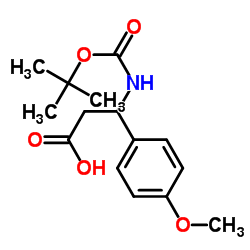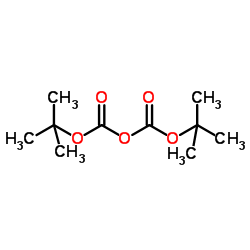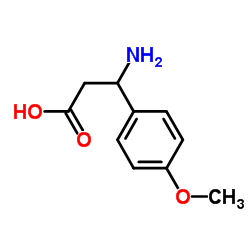3-N-Boc-Amino-3-(4-methoxyphenyl)propionic acid
Modify Date: 2025-08-27 10:12:56

3-N-Boc-Amino-3-(4-methoxyphenyl)propionic acid structure
|
Common Name | 3-N-Boc-Amino-3-(4-methoxyphenyl)propionic acid | ||
|---|---|---|---|---|
| CAS Number | 96363-20-1 | Molecular Weight | 295.331 | |
| Density | 1.2±0.1 g/cm3 | Boiling Point | 463.2±45.0 °C at 760 mmHg | |
| Molecular Formula | C15H21NO5 | Melting Point | 167-169ºC (dec.) | |
| MSDS | N/A | Flash Point | 233.9±28.7 °C | |
| Name | 3-(4-methoxyphenyl)-3-[(2-methylpropan-2-yl)oxycarbonylamino]propanoic acid |
|---|---|
| Synonym | More Synonyms |
| Density | 1.2±0.1 g/cm3 |
|---|---|
| Boiling Point | 463.2±45.0 °C at 760 mmHg |
| Melting Point | 167-169ºC (dec.) |
| Molecular Formula | C15H21NO5 |
| Molecular Weight | 295.331 |
| Flash Point | 233.9±28.7 °C |
| Exact Mass | 295.141968 |
| PSA | 84.86000 |
| LogP | 2.63 |
| Vapour Pressure | 0.0±1.2 mmHg at 25°C |
| Index of Refraction | 1.522 |
| InChIKey | OPAAZWPTEYZZIW-UHFFFAOYSA-N |
| SMILES | COc1ccc(C(CC(=O)O)NC(=O)OC(C)(C)C)cc1 |
| Storage condition | Freezer (-20°C) |
Synonym:3-N-(TERT-BUTOXYCARBONYL)-AMINO-3-(4-METHOXYPHENYL)PROPIONIC ACI Section 2 - COMPOSITION, INFORMATION ON INGREDIENTS
Risk Phrases: 36/37/38 Section 3 - HAZARDS IDENTIFICATION EMERGENCY OVERVIEW Irritating to eyes, respiratory system and skin. Potential Health Effects Eye: Causes eye irritation. Skin: Causes skin irritation. May be harmful if absorbed through the skin. Ingestion: May cause irritation of the digestive tract. May be harmful if swallowed. Inhalation: Causes respiratory tract irritation. May be harmful if inhaled. Chronic: Effects may be delayed. Section 4 - FIRST AID MEASURES Eyes: Flush eyes with plenty of water for at least 15 minutes, occasionally lifting the upper and lower eyelids. Get medical aid. Skin: Get medical aid. Flush skin with plenty of soap and water for at least 15 minutes while removing contaminated clothing and shoes. Wash clothing before reuse. Ingestion: Get medical aid. Do NOT induce vomiting. If conscious and alert, rinse mouth and drink 2-4 cupfuls of milk or water. Wash mouth out with water. Inhalation: Remove from exposure to fresh air immediately. If not breathing, give artificial respiration. If breathing is difficult, give oxygen. Get medical aid. Notes to Physician: Treat symptomatically and supportively. Section 5 - FIRE FIGHTING MEASURES General Information: As in any fire, wear a self-contained breathing apparatus in pressure-demand, MSHA/NIOSH (approved or equivalent), and full protective gear. During a fire, irritating and highly toxic gases may be generated by thermal decomposition or combustion. Extinguishing Media: Use water spray, dry chemical, carbon dioxide, or appropriate foam. Section 6 - ACCIDENTAL RELEASE MEASURES General Information: Use proper personal protective equipment as indicated in Section 8. Spills/Leaks: Clean up spills immediately, observing precautions in the Protective Equipment section. Sweep up or absorb material, then place into a suitable clean, dry, closed container for disposal. Avoid generating dusty conditions. Provide ventilation. Section 7 - HANDLING and STORAGE Handling: Minimize dust generation and accumulation. Avoid contact with eyes, skin, and clothing. Keep container tightly closed. Avoid ingestion and inhalation. Use with adequate ventilation. Wash clothing before reuse. Storage: Store in a tightly closed container. Store in a cool, dry, well-ventilated area away from incompatible substances. Section 8 - EXPOSURE CONTROLS, PERSONAL PROTECTION Engineering Controls: Facilities storing or utilizing this material should be equipped with an eyewash facility and a safety shower. Use adequate ventilation to keep airborne concentrations low. Personal Protective Equipment Eyes: Wear chemical goggles. Skin: Wear appropriate protective gloves to prevent skin exposure. Clothing: Wear appropriate protective clothing to prevent skin exposure. Respirators: Follow the OSHA respirator regulations found in 29 CFR 1910.134 or European Standard EN 149. Always use a NIOSH or European Standard EN 149 approved respirator when necessary. Section 9 - PHYSICAL AND CHEMICAL PROPERTIES Physical State: Solid Color: white Odor: Not available. pH: Not available. Vapor Pressure: Not available. Viscosity: Not available. Boiling Point: Not available. Freezing/Melting Point: Not available. Autoignition Temperature: Not available. Flash Point: Not available. Explosion Limits, lower: Not available. Explosion Limits, upper: Not available. Decomposition Temperature: Solubility in water: Specific Gravity/Density: Molecular Formula: C15H21NO5 Molecular Weight: 295.1507 Section 10 - STABILITY AND REACTIVITY Chemical Stability: Not available. Conditions to Avoid: Not available. Incompatibilities with Other Materials: Not available. Hazardous Decomposition Products: Nitrogen oxides, carbon monoxide, carbon dioxide. Hazardous Polymerization: Not available. Section 11 - TOXICOLOGICAL INFORMATION RTECS#: CAS# 96363-20-1 unlisted. LD50/LC50: Not available. Carcinogenicity: 3-N-BOC-AMINO-3(4-METHOXYPHENYL)PROPIONIC ACID - Not listed by ACGIH, IARC, NIOSH, NTP, or OSHA. See actual entry in RTECS for complete information. Section 12 - ECOLOGICAL INFORMATION Section 13 - DISPOSAL CONSIDERATIONS Dispose of in a manner consistent with federal, state, and local regulations. Section 14 - TRANSPORT INFORMATION IATA No information available. IMO No information available. RID/ADR No information available. Section 15 - REGULATORY INFORMATION European/International Regulations European Labeling in Accordance with EC Directives Hazard Symbols: XI Risk Phrases: R 36/37/38 Irritating to eyes, respiratory system and skin. Safety Phrases: S 26 In case of contact with eyes, rinse immediately with plenty of water and seek medical advice. S 37/39 Wear suitable gloves and eye/face protection. WGK (Water Danger/Protection) CAS# 96363-20-1: No information available. United Kingdom Occupational Exposure Limits United Kingdom Maximum Exposure Limits Canada None of the chemicals in this product are listed on the DSL/NDSL list. CAS# 96363-20-1 is not listed on Canada's Ingredient Disclosure List. Exposure Limits US FEDERAL TSCA CAS# 96363-20-1 is not listed on the TSCA inventory. It is for research and development use only. SECTION 16 - ADDITIONAL INFORMATION N/A |
| Hazard Codes | Xi:Irritant; |
|---|---|
| Risk Phrases | R36/37/38 |
| Safety Phrases | S26-S37/39 |
| HS Code | 2922509090 |
|
~85% 
3-N-Boc-Amino-3... CAS#:96363-20-1 |
| Literature: Kalvin, Douglas M.; Woodard, Ronald W. Journal of Organic Chemistry, 1985 , vol. 50, # 13 p. 2259 - 2263 |
|
~% 
3-N-Boc-Amino-3... CAS#:96363-20-1 |
| Literature: Journal of Organic Chemistry, , vol. 50, # 13 p. 2259 - 2263 |
| Precursor 3 | |
|---|---|
| DownStream 0 | |
| HS Code | 2922509090 |
|---|---|
| Summary | 2922509090. other amino-alcohol-phenols, amino-acid-phenols and other amino-compounds with oxygen function. VAT:17.0%. Tax rebate rate:13.0%. . MFN tariff:6.5%. General tariff:30.0% |
| 3-[(tert-butoxycarbonyl)amino]-3-(4-methoxyphenyl)propanoic acid |
| 3-tert-Butoxycarbonylamino-3-(4-methoxy-phenyl)-propionic acid |
| MFCD02090694 |
| Benzenepropanoic acid, β-[[(1,1-dimethylethoxy)carbonyl]amino]-4-methoxy- |
| 3-(4-Methoxyphenyl)-3-({[(2-methyl-2-propanyl)oxy]carbonyl}amino)propanoic acid |
| 3-(Boc-amino)-3-(4-methoxyphenyl)propionic acid |
| D,L-3-{[(1,1-dimethylethoxy)carbonyl]amino}-3-(4-methoxyphenyl)propanoic acid |
| Boc-3-Amino-3-(4-methoxyphenyl)propionic acid |


